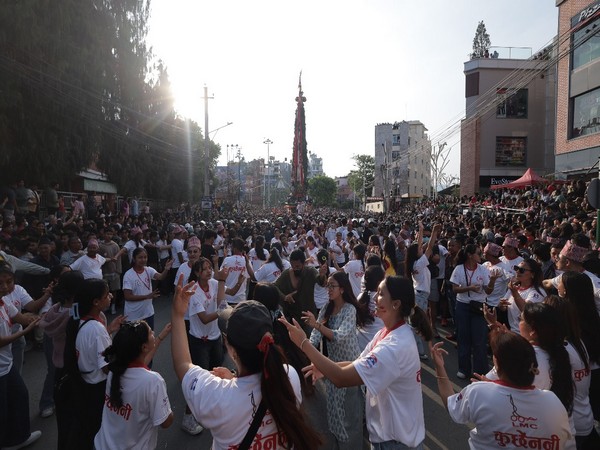
Lalitpur: The Rato Macchindranath or Bunga Dugh in Newa chariot festival, one of Nepal's most revered festivals, has begun in the ancient town of Patan, Lalitpur, traversing through the sea of devotees on Thursday, the longest chariot procession of Nepal.
The festival, which honours the God of Rain and Harvest, features a 42-foot-tall chariot carrying the deity through the streets, accompanied by traditional music and rituals.
The festival is deeply rooted in Nepalese culture and folklore. According to legend, the chariot procession was started in 897 AD to commemorate Lord Macchendranath's feat of bringing rain to the city of Patan after a severe drought. The festival celebrates the deity's power to bring prosperity and rainfall to the region.
The chariot is constructed annually by the Newa community using wooden beams and traditional craftsmanship, without using a single nail. The procession runs for over a month and is led by troupes of musical performers and features traditional rituals and ceremonies.
"The preparations start a month before. Jatra brings vibrancy and cheerful moments to us. We are always happy to be involved and hold training to play the musical instruments, which gives us the satisfaction and continues the tradition," Ujjwal, one of the members of the performing musical troupe, told ANI.
According to the lunar calendar, the longest chariot festival of Nepal begins on the 4th day of the bright fortnight of Bachhala, the seventh month in the lunar Nepal Sambat calendar. Still, this year it didn't fall as per the set-out rule.
"As per the folklore, the Kathmandu Valley hadn't received rainfall, leading to a serious drought; lord Macchindranath had to be brought to Nepal from Kamakhya in India. The King of Bhaktapur, Gubhaju from Kathmandu and Jyapus from Lalitpur had gone to bring him here; with the solution of the problem, the god of rain and prosperity is worshipped performing a chariot procession," Ujjwal added.
One popular legend states that once Guru Gorakhnath came to the city of Patan, but wasn't acknowledged by the people living there. As the commoners didn't offer him food and ignored him, Guru Gorakhnath captured all the serpents and held them captive. As the "Naags," or serpents responsible for precipitation, were held captive by Guru Gorakhnath, Patan experienced a drought.
The then-king of Patan, Narendrea Dev, asked his advisors to bring the teacher of Gorakhnath, Lord Macchendranath, from Assam. Hearing about the teacher's presence in the town, Guru Gorakhnath stood up from his seat, letting the serpents loose, which brought rain to the city, ending the drought.
The Rato Macchindranath festival is integral to Nepal's cultural heritage, showcasing the country's rich traditions and customs. The 2015 earthquake and the COVID-19 pandemic disrupted the festival, but it has now resumed, bringing vibrancy and cheer to the people of Patan.
There is a belief that the residents of Bhaktapur can pull the chariot to their place and keep the god for 6 months if the procession fails to take place before Dashain, the major fortnightly festival observed in Nepal during the month of October.